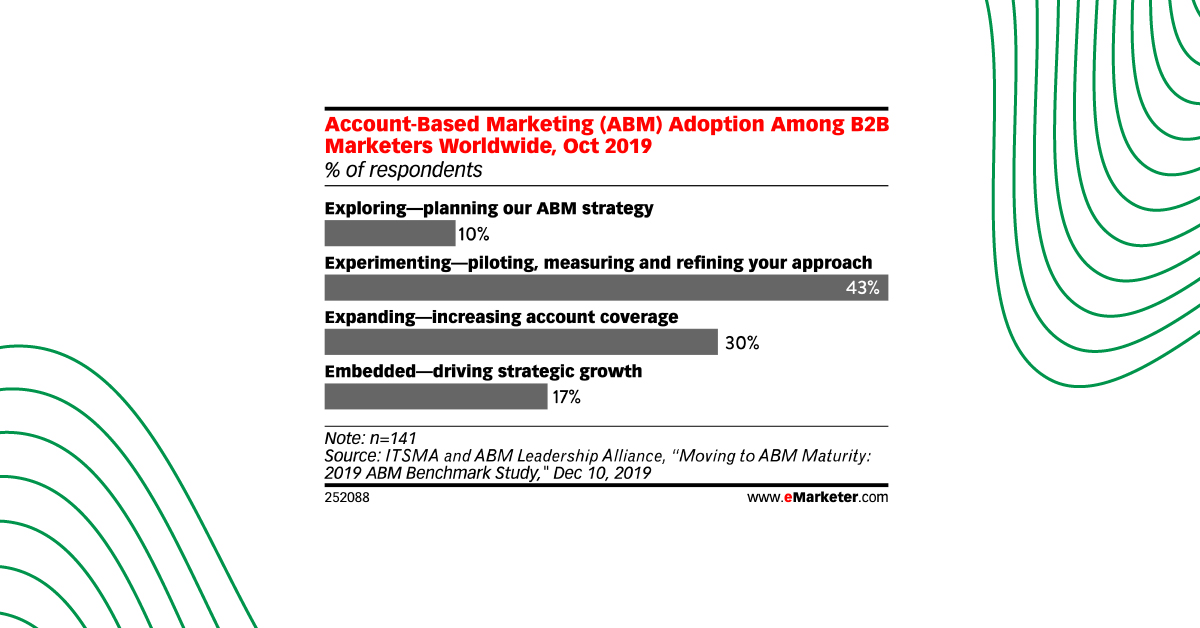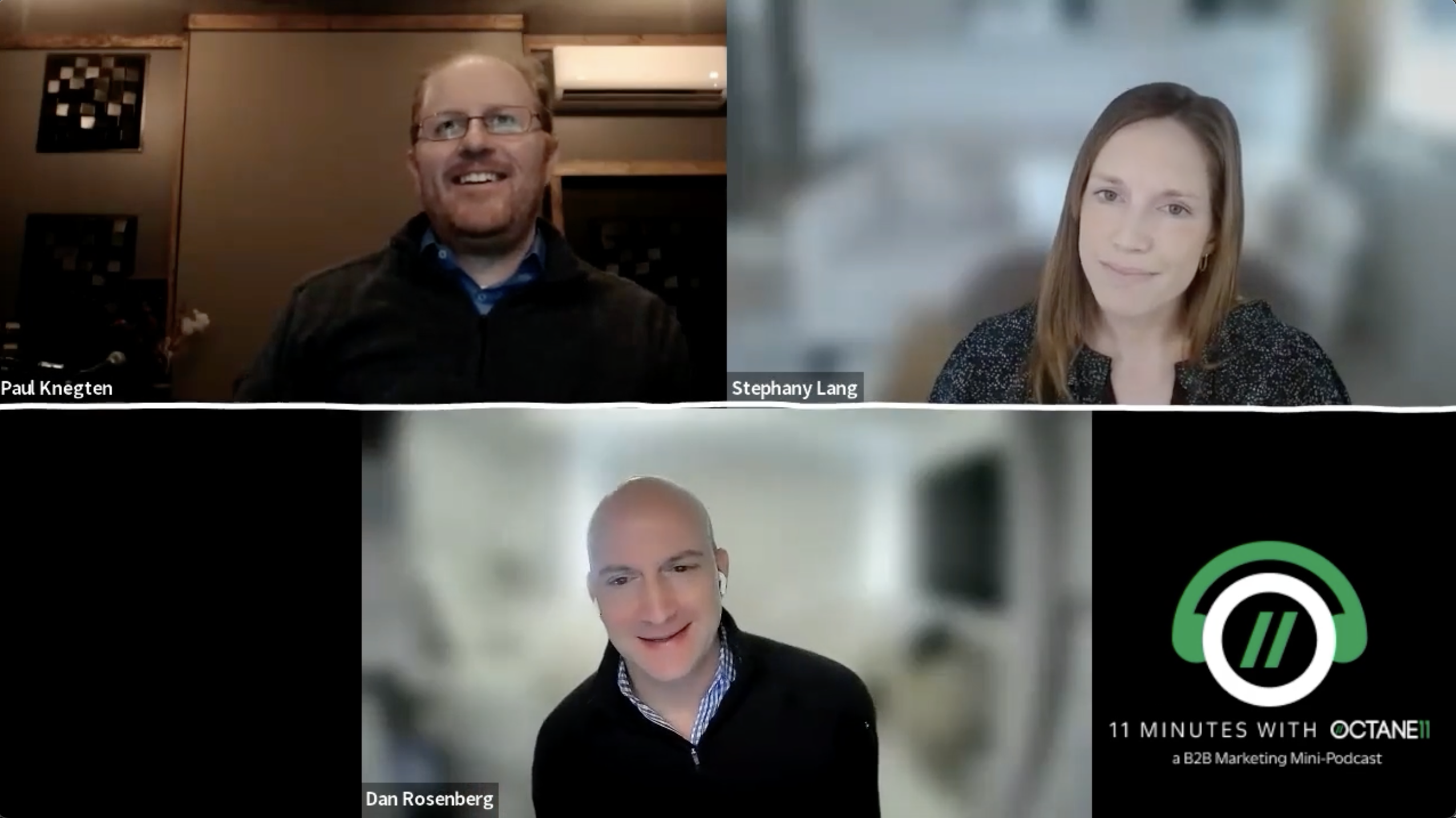Account-Based Marketing (or ABM) has become the hottest topic in the world of B2B marketing…so why have so few companies successfully adopted it?! In April 2020, Jillian Ryan and team at eMarketer reported in their deep dive analysis of the state of ABM (“Account-Based Strategies in 2020”) that “only 17% of B2B marketers worldwide said their ABM program was mature and driving strategic growth.” The other 83% were either just getting started or “exploring” the concept altogether. While most agree that ABM’s focus on account-driven targeting, messaging, and measurement is ideal for B2B marketing, eMarketer calls out the top 10 biggest perceived challenges for getting started. In this week’s post, I’ll provide some actionable ideas on how to battle through the top 5 challenges, and next week I’ll round it out with thoughts on the remaining 5 challenges.
The Top 10 Biggest Challenges for US Marketing Professionals Implementing Account-Based Marketing According to an eMarketer Survey in Q4 2019:
1) “Ensuring you have the right content for an account-based approach”
It’s surprising to me that this one is at the top of the list. I would argue that you already have plenty of content for an ABM approach – in your sales decks, product sheets and even your existing website. The key to making that content usable is to take the “blockbuster” approach that I discussed in a previous post that looks at how to apply lessons from Disney to B2B Marketing. Identify your best existing content (either by polling your sales team or looking at historical engagement rates on emails, social posts, ads, web pages, etc) and repurpose it by breaking it into piece parts or by creating a simple “part two” update. No need to reinvent the wheel; create “blockbusters” with content you know is already working.
2) “Difficulty measuring & reporting on account-level results”
Measuring ABM impact and delivering actionable insights at the account level to leverage signals across all digital channels is a critical component for ABM — and unfortunately it’s clearly the biggest gap as well. In fact, addressing this issue is the main reason why we formed Octane11 in the first place. The key is to connect all activities into a central data warehouse and tag all digital signals with the notion of both an account and a campaign. From there you can develop a wide range of reports and insights…and even feed that enriched data to a machine learning engine to develop predictions. If you’re struggling with this step, reach out to us at www.octane11.com, it’s what we do!
3) “Building out account and contact data”
This is another big one and the good news is that there are some great companies that have been addressing this challenge, including Bombora, Dun & Bradstreet, EverString (now part of ZoomInfo / DiscoverOrg), Data Axle (fka Infogroup), Adstra (fka ALC). No surprise that there has been so much M&A and rebranding in this space as of late – it’s a cornerstone category! One observation we’ve made over time is that you should expect about 30% of your contacts to be invalid at any given time. People change jobs so quickly these days that it’s just hard for the data to keep up. LinkedIn’s self-reported data is also typically very accurate, but it’s not quite designed for bulk usage. In our experience, it’s best to include that 30% error rate in your expected cost per contact.
4) “Aligning sales and marketing on key accounts”
Developing an agreed upon list of “Target Accounts” is critical! In our experience, there are two lenses: (a) External Data (eg. Firmographics like size, geography, industry, etc; and Technographics like other vendors and products in use), and (b) Proprietary Data (eg. knowing what a prospect’s level of familiarity is with your product category, where the decision-making power lies, etc). If you can agree on the hallmarks of your “Ideal Customer Profile” (typically by analyzing your best clients), filter down to a workable list using the external data from partners like those listed in #3 above, and then add your own internal insights, then you should end up with a great starter list that you can continue to iterate over time.
5) “Moving away from lead-based volume metrics”
Generating a high volume of leads is great – BUT only if those leads are: (a) from companies that meet your well-defined ideal customer profile and (b) come with more intel than just a name – like what topics they might be interested in, the content they consumed, or the frequency and volume of engagement (an indicator of urgency), etc. That being said, before you start ratcheting down your lead volume, be sure you make the case for quality over quantity by analyzing the portion of your historical leads that came from Target Accounts and how well they converted into paying customers. Once you’ve made the case for lower volume, higher quality “leads” you can then start to build back volume by investing in more marketing activity – and by sharing digital signals (like email clicks, social likes, ad clicks, extended website visits, etc.) from companies that didn’t quite raise their hands via a form fill, but are showing enough intent to warrant a sales team outreach.
Getting started with ABM could be the greatest move you make as a B2B marketer, but there is definitely a learning curve – and it’s important to set yourself up for success with the right partners and tools. If you’re facing these challenges and would like to dig deeper in how to solve them, reach out to us via LinkedIn or talk with our chatbot at www.octane11.com. We can guide you through tackling all of them.
In the meantime, look out for next week’s post where I’ll review the remaining 5 biggest challenges for implementing ABM on eMarketer’s list.
6) “Using consistent data across systems”
7) “Implementing the right technology”
8) “Getting internal buy-in from key stakeholders”
9) “Allocating budget to account-based initiatives”
10) “Time to results is too long”





